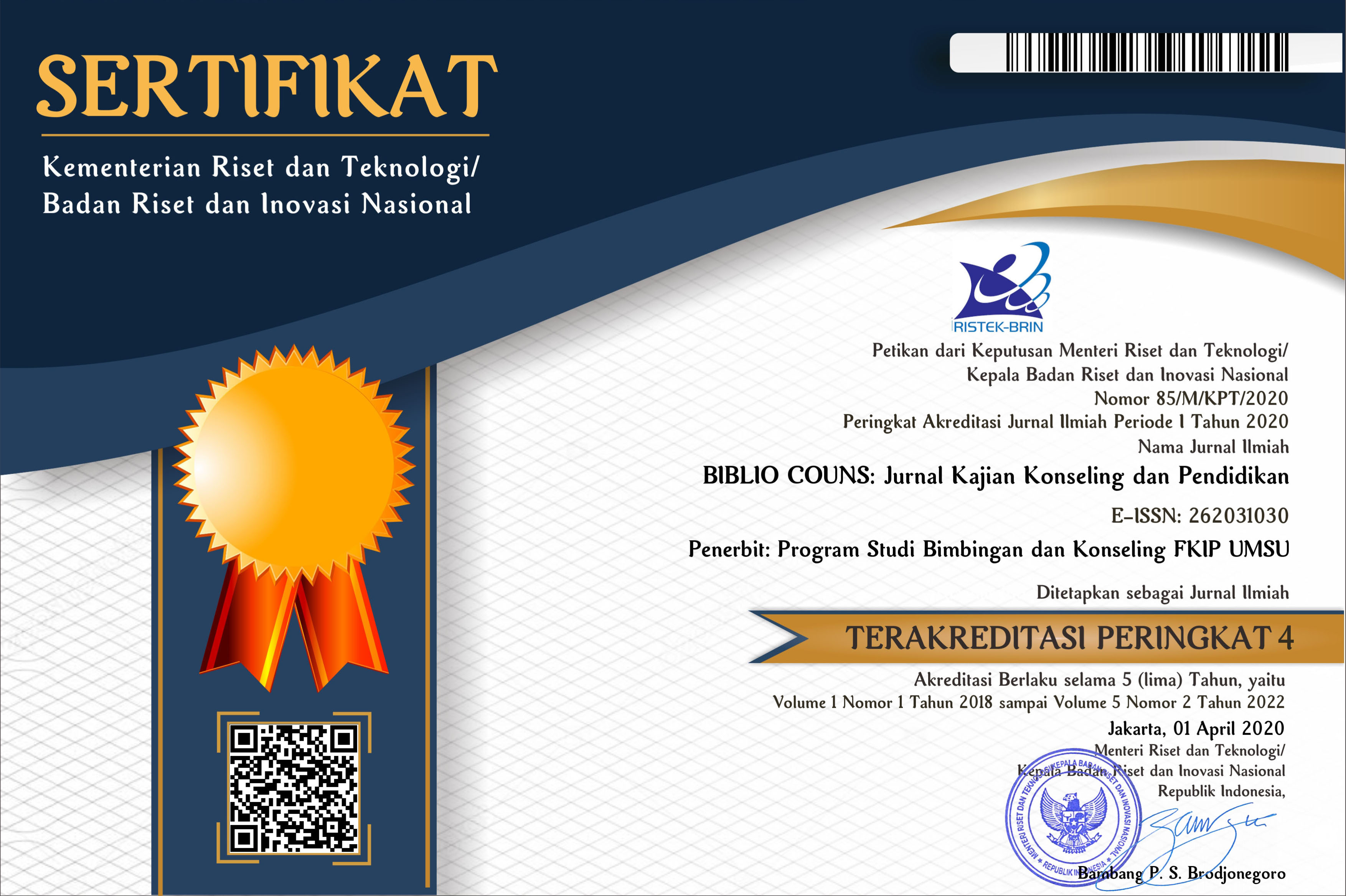Efektifitas Bimbingan Kelompok Teknik Homeroom Untuk Mengurangi Perilaku Bullying Pada Remaja
Abstract
This research is motivated by the many bullying behaviors in schools, bullying is a desire to hurt someone. In addition, this study was conducted with the aim of testing the effectiveness of group guidance with the homeroom technique in reducing student bullying behavior before and after being given treatment (experiment). This research uses quantitative research methods. This research is a pre experimental design using one group design pretest-posttest design because this design is designed to compare a treatment. In this study, quantitative data were obtained from a questionnaire instrument or a revealing questionnaire of 3.3% bullying behavior. The population in this study were 240 students of class XI MAN Blitar City. The sampling technique used purposive sampling, so that the sample of this study amounted to 8 students. The data analysis technique used is the t-test pired sample t-test. The results of this study indicate that a significant value of 0.000 <0.05 means that H0 is rejected. Ha is accepted, that is, after group guidance with the homeroom technique is carried out, bullying behavior decreases. This means that group guidance is effective in overcoming bullying behavior in students at MAN Kota Blitar. The conclusion of this research is group guidance with the homeroom technique is effective to overcome the bullying behavior of students of Class XI MAN Kota Blitar.
Keywords
Full Text:
PDFReferences
Ahmad, K. (2016). Efektivitas Bimbingan Kelompok Islami Untuk Meningkatkan Aspirasi Karir Mahasiswa. Jurnal Psikopedogogia.
Al-Maraghi, A. M. (1993). Terjemah Tafsir Al-Maraghi 26. CV. Toha Putra.
Departemen Agama Republik Indonesia. (2005). Al-Quran dan Terjemahnya Al-Jumanatul 'Ali Seuntai Mutiara yang Maha Luhur. CV. Penerbit J-ART.
Husna, N. . (2015). PENGARUH LAYANAN BIMBINGAN KELOMPOK DENGAN TEKNIK PERMAINAN TERHADAP PENYESUAIAN DIRI SISWA. Universitas Negeri Semarang.
Jalal al-Din al-Suyuti. (1991). Lubab al-Nauqul fi Asbab al-Nuzul, dalam Tafsir Al-Quran Al-Azim. Dar al-Fikr.
Kurnia, I. (2016). BULLYING. RELASI INTI MEDIA.
Marliani, R. (2016). Psikologi Perkembangan Anak dan Remaja . CV Pustaka Setia.
Nurihsan, A. . (2005). Strategi Layanan Bimbingan & Konseling. PT. Refika Aditama.
Nursalim, M. dan S. (2002). Layanan bimbingan dan konseling. University Press.
Paluhulawa, M., & M. Rizki Djibran, M. R. . (2017). Layanan Bimbingan Kelompok dan Pengaruhnya Terhadap Self-Esteem Siswa. In Proceeding Seminar Loka Karya Nasional Revitalisasi L.
Salahudin, A. (2010). Bimbingan kelompok. Pustaka Ceria.
Santrock, J. . (2003). Adolescence : Perkembangan Remaja. Erlangga.
Sugiyono. (2017). Metode Penelitian Kuantitatif, Kualitatif dan R&C. ALFABETA.
Syamsul Arifin, B. (2015). Dinamika Kelompok. CV Pustaka Setia.
Tatiek, R. (2006). Teori & Praktek Bimbingan Kelompok . Universitas Negeri Malang.
Winkel, W. (1997). Bimbingan dan Konseling Di Isntitusi Pendidikan. PT. Gramedia Widiasarana.
Yayasan Semai Jiwa Amni (SEJIWA). (2008). BULLYING: Mengatasi Kekerasan di Sekolah dan Lingkungan . Grasindo.
Yusuf, A. . (2013). Metode Penelitian : Kuantitatif, Kulaitatif dan Penelitian Gabungan. UNP Press.
DOI: https://doi.org/10.30596/bibliocouns.v5i1.6831
Refbacks
- There are currently no refbacks.
Biblio Couns: Jurnal Kajian Konseling dan Pendidikan
Universitas Muhammadiyah Sumatera Utara
Kampus Utama
Jl. Kapten Muchtar Basri No.3, Glugur Darat II,Medan
Sumatera Utara-20238
E-mail: jbcons@umsu.ac.id



